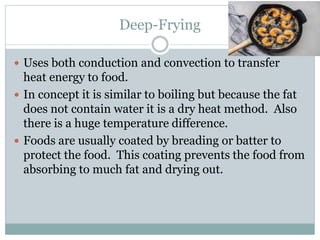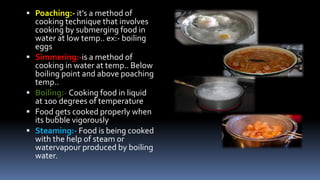Explain the Different Methods of Cooking for Preserving Nutrients
Slow cookers allow you to assemble ingredients in the pot of the slow cooker. Three Types of Food.

All Lite Food Ways To Preserve Nutrients While Cooking Vegetables In 2022 Vegetables Cooked Vegetables Nutrient
To steam vegetables fill the bottom of a steamer pot with 5cm 2 inches of water.

. Researchers have found that steaming broccoli spinach and lettuce reduces their vitamin C. Steaming is one of the best methods to preserve the nutrients and flavour of your vegetables. Provides proper structure to the blood vessels bones and ligaments.
Root crops such as potatoes carrots rutabagas turnips parsnips and then cabbages kale spinach and some leaf lettuces can all stay in the ground with proper protection. So to make food preservation economical and safe we need more flexible methods. Sugar is a good moisture absorbent.
Understanding and mastering the different types of cooking methods is essential to becoming. The three types of cooking methods are dry heat cooking moist heat cooking and combination cooking. Then the vegetables must be rapidly cooled in.
Each value is meanSD of three replicate samples. Cooking can be advantageous in many ways including. Wait for the water to come to a rapid boil before adding vegetables into the steamer basket and steam for a required amount of time.
Olive oil says Ma ggie Michalczyk MS RD. Do eat with skin on whenever possible. Not every method is pocket-friendly.
Stir-frying is a great cooking method and helps to retain a lot of the veggies nutrition but its important to use the right oils. Modern food preservation has benefited greatly from advancements in packaging materials. People can preserve food according to their convenience.
Functions of Nutrients. A great method to retain as many nutrients as possible is steaming. The important functions of nutrients include.
Steaming is a water based cooking method and is one of the best cooking methods for preserving nutrients including water-soluble vitamins that are sensitive to heat and water. Canning preserves food by removing the oxygen needed for most microorganisms to grow. Slow cooking uses low heat to cook food over a long period of time.
Bacteria and yeast grow best at specific temperatures usually between 40 F to 140 F. Increases the absorption of fat-soluble vitamins. Salt and edible oils are two main preservatives which are used since ages to prevent microbial growth.
Food has different properties. All cooking techniques from grilling to steaming can be grouped under one of these three methods. They are the main source of energy for the body.
For this type of high heat cooking I would recommend using avocado oil because it has a higher smoke point therefore it can better withstand high heat vs. Blanching is the exposure of the vegetables to boiling water or steam for a brief period of time. The contents of vitamin C and total carotenoids in broccoli cooked by different methods.
Heat and Cold Methods. The science of fermentation is called zymology and it involves a chemical change in food that uses organic acids to change microorganisms under anaerobic conditions. One traditional method of food preservation fermenting can add beneficial microbes to your diet.
Baking soda makes cooking water alkaline and thus helps retain the colour of vegetables as well as speed up the cooking process BUT it destroys thiamine and vitamin C. Enzymes in vegetables are deactivated by the blanching process. Since some organisms can.
D Concentration of vitamins expressed as mg100 g as dry weight basis. Helps in the synthesis of collagen. They help in building and repairing body tissues.
Invest in a simple steamer or try cooking your vegetables with minimal water over very low heat until just cooked. Blanch vegetables to deactivate enzymes. Consider this as one of the great ways to preserve food.
Deep frying and heating for a long time or heating at a high temperature should be avoided during cooking. This cooks food very quickly. Alternative cooking methods such as grilling roasting steaming stir-frying or microwaving generally preserve a greater amount of vitamins and other nutrients.
Pressure cooking uses steam that is sealed in an airtight pressure cooker to cook food. Food Preservation Methods Chemical Method. Why Do We Need Different Methods to Preserve Food.
Each of these methods uses heat to affect foods in a different way. Thus the methods of preserving them can be different. However it is the least effective method for.
1 Steam your vegetables. Boiling is perhaps the most popular method used to cook vegetables. 2 Avoid boiling.
Fermentation is often referred to as living culture food and this is the method of food preservation that has been around the longest. Drying refrigeration and fermentation are some of the oldest methods of preservation. Benefits of cooking food.
Sugar is another common preservative used in jams and jellies. Values not sharing a common letter are significantly different at P. In conclusion the present study examined the effect of different cooking methods including blanching boiling microwaving and steaming on the content and true retention of β-carotene ascorbic acid vitamins E and vitamin K in vegetables.
Making the food tastier. It would be inaccurate to say that cooking food always lessens the nutrient value. Pressure cooking is often used to cook.
Pickling is a standard from of food storage. All food can be classified into one of three groups which require different storage methods. Canning pasteurisation freezing irradiation and chemical addition are all examples of modern processes.
Common Methods of Food Preservation Chilling and Freezing.

Food Nutrition And Recipes For A Healthy Lifestyle Food Infographic Nutrition Recipes Healthy Cooking


Comments
Post a Comment